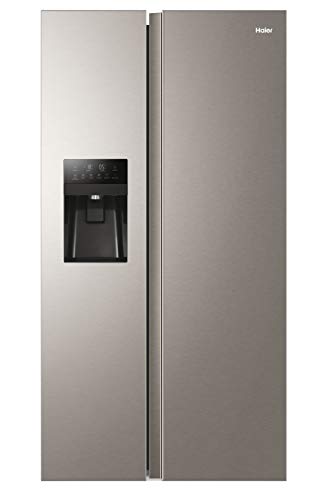Fridges's History History Of Fridges
페이지 정보

본문
How to Keep Your Fridge Running Smoothly
Refrigerators are available in a variety of different sizes and shapes. They can fit into tight areas, like dorm rooms.
Certain models also connect to smart devices. They'll let you monitor your fridge remotely and troubleshoot any problems that might occur. You can also make use of voice commands to control them.
Noise
Fridges make a wide range of noises while they are in operation. Certain noises are more prominent than others. If you notice any of the sounds below, determine its origin and check for a quick fix prior to calling a repair company for your fridge.
Rattling
The fridge can rattle when there's not enough space between it and the cabinet or wall or if it's sitting at an unlevel angle. It's not difficult to fix. It's all you need to do is ensure that there's at least two inches between the fridge and the wall or cabinet, or you can adjust the leveling legs or screws to increase or decrease the height of your fridge.
Hissing
The compressor could make a loud noise while cooling your food. This is a normal sound that is caused by the refrigerant or compressor fluid that is moving through the system. If you're concerned be aware of the frequency at which the compressor cycles. Call a fridge repair service immediately if this happens more than normal.
Squeaking
 Refrigerators can sound raucous if the coils or fan are dirty. If you hear a squeaking sound coming from your refrigerator, you can use a vacuum cleaner brush attachment or a rag along with dish soap or water along with warm water to wash the fan and coils. It is essential to do this every two years and more frequently if your buy fridge freezer is older or used heavily.
Refrigerators can sound raucous if the coils or fan are dirty. If you hear a squeaking sound coming from your refrigerator, you can use a vacuum cleaner brush attachment or a rag along with dish soap or water along with warm water to wash the fan and coils. It is essential to do this every two years and more frequently if your buy fridge freezer is older or used heavily.
Clicking
A clicking sound can also be heard from a fridge. It is usually due to ice around the freezer fan. Manual defrosting can solve the issue however it is likely to recur in the event that a professional is not called to assist.
The clicking can also occur when the fridge is shut off, so make sure to restart it if this occurs. This sound can also be caused by an Ice maker if you have one, so it's important to ensure that it's turned off when you don't require ice continuously.
The hum of your refrigerator is normal, and it may be louder at certain times of the day, or after heavy stockings or intense freezing functions. The refrigerator is working harder to keep your food cool, which means it has to work faster. This is not an indication of any issue.
Dust
Dust from the household is a magnet for dirt, bacteria and other microorganisms, as well as traces of chemical exposures that are commonplace in the household. The tiny particles can cause allergic reactions as well as inhalation, and they are a perfect substrate for microbes, which includes those that can cause an infection when they come into contact with a cut.
Cleaning a refrigerator is not easy, but regular cleaning can help reduce dust and keep the temperature at a constant level. A dirty fridge also consumes energy as it gets overheated and performs inefficiently. If your fridge is producing more noise than normal or if you think it's running out of energy due to overworking it could be time to have it checked.
Contrary to other airborne particles dust doesn't simply drift into the air from outside as is often believed. It contains resuspended dirt from the house and can be contaminated with lead or other poisonous substances. It also contains pollen, mold and car exhaust. It also contains a number of legacy pollutants, including DDT which was banned 50 years ago.
Certain compounds, such as flame retardants such as decabromodiphenylether are able to volatilize and enter the air, but the majority of chemicals in dust in the house are transferred directly from one object to another, such as by people knocking fibers and minute bits of plastic off of electronic equipment. High-molecular-weight substances, such as surfactants used in cleaners and paint strippers, also migrate directly into dust.
In addition to contaminating food items in the refrigerator, a smoky refrigerator can also affect your health. It could harbor allergens such as pet dander or cockroach droppings that can trigger asthma attacks and allergies. It can also contain bacteria spores like staphylococcus aureus, that can cause infection if they make their way into a wound.
Researchers have discovered that a variety of health issues are linked to contaminated dust, from cardiovascular disease to cancer to leukemia and inflammatory bowel diseases. Recent research revealed that dust in the homes of children suffering from leukemia had higher levels PCBs, PBDEs, and polycyclic aromatic hydrocarbons.
Condenser Coils
If refrigerators are operating properly, the coils that are on the front and back of the appliance are supposed to disperse heat generated by the compressor. If these radiator-like components are covered in pet hair, dust or lint, the compressor has to work hard trying to cool the refrigerator, which wears down the appliance. That's why it's so important to clean the coils regularly.
Before starting, disconnect and turn off the refrigerator's power supply. This will decrease the chance that you or your family members could be injured by electrocution while working on the appliance. If you're allergic to dust, it's recommended to wear a face mask. Then, you'll have to locate the coils. They are typically located at the rear of the fridge, or on the front, across the base in certain models. If you are unsure where to find them, consult your fridge's owner manual or contact the manufacturer for more information.
Once you have found the coils, you'll have to take off the access panel if there is one. You can then alternate between vacuuming the coils using an hose attachment that is narrow and rubbing them with a condenser brush for cleaning the coils. Be cautious not to risk damaging or bent coils. Replace the kick panel, or push the refrigerator into position, then plug it in.
You can employ an expert if you're comfortable doing it yourself. It's cheaper and simpler to keep up the cleaning routine in order to prevent the problem.
Maintenance
Refrigerators are powerful appliances that work all day long to cool your food. To make sure they are doing their jobs well they require regular maintenance. Simple preventive maintenance can ensure that your machines are running smoothly for many years.
Wipe down the door seals. The gaskets may become blocked by jelly and other food items that stick and allow cool air to escape through tiny gaps. Clean them off using a mixture of baking soda and warm water on a sponge or toothbrush every few months.
Another spot to check for issues is the fan in the back of the fridge. It can become noisy when it's clogged with paper, insulation or even a mouse (gasp). Unplug the fridge, take out all the shelves and take out any parts that are removable. Clean the coils as well as the area around them with a vacuum cleaner with a hose attachment. Make sure you turn the fridge freezers uk sale, similar web-site, off when you're done.
It is recommended that you read your owner's guide for information on where to find the coils, the fan and the tools for cleaning you might require. It's also a good idea to read the warranty carefully, to be sure you know what's covered and what isn't covered.
Refrigerators are available in a variety of different sizes and shapes. They can fit into tight areas, like dorm rooms.
Certain models also connect to smart devices. They'll let you monitor your fridge remotely and troubleshoot any problems that might occur. You can also make use of voice commands to control them.
Noise
Fridges make a wide range of noises while they are in operation. Certain noises are more prominent than others. If you notice any of the sounds below, determine its origin and check for a quick fix prior to calling a repair company for your fridge.
Rattling
The fridge can rattle when there's not enough space between it and the cabinet or wall or if it's sitting at an unlevel angle. It's not difficult to fix. It's all you need to do is ensure that there's at least two inches between the fridge and the wall or cabinet, or you can adjust the leveling legs or screws to increase or decrease the height of your fridge.
Hissing
The compressor could make a loud noise while cooling your food. This is a normal sound that is caused by the refrigerant or compressor fluid that is moving through the system. If you're concerned be aware of the frequency at which the compressor cycles. Call a fridge repair service immediately if this happens more than normal.
Squeaking
 Refrigerators can sound raucous if the coils or fan are dirty. If you hear a squeaking sound coming from your refrigerator, you can use a vacuum cleaner brush attachment or a rag along with dish soap or water along with warm water to wash the fan and coils. It is essential to do this every two years and more frequently if your buy fridge freezer is older or used heavily.
Refrigerators can sound raucous if the coils or fan are dirty. If you hear a squeaking sound coming from your refrigerator, you can use a vacuum cleaner brush attachment or a rag along with dish soap or water along with warm water to wash the fan and coils. It is essential to do this every two years and more frequently if your buy fridge freezer is older or used heavily.Clicking
A clicking sound can also be heard from a fridge. It is usually due to ice around the freezer fan. Manual defrosting can solve the issue however it is likely to recur in the event that a professional is not called to assist.
The clicking can also occur when the fridge is shut off, so make sure to restart it if this occurs. This sound can also be caused by an Ice maker if you have one, so it's important to ensure that it's turned off when you don't require ice continuously.
The hum of your refrigerator is normal, and it may be louder at certain times of the day, or after heavy stockings or intense freezing functions. The refrigerator is working harder to keep your food cool, which means it has to work faster. This is not an indication of any issue.
Dust
Dust from the household is a magnet for dirt, bacteria and other microorganisms, as well as traces of chemical exposures that are commonplace in the household. The tiny particles can cause allergic reactions as well as inhalation, and they are a perfect substrate for microbes, which includes those that can cause an infection when they come into contact with a cut.
Cleaning a refrigerator is not easy, but regular cleaning can help reduce dust and keep the temperature at a constant level. A dirty fridge also consumes energy as it gets overheated and performs inefficiently. If your fridge is producing more noise than normal or if you think it's running out of energy due to overworking it could be time to have it checked.
Contrary to other airborne particles dust doesn't simply drift into the air from outside as is often believed. It contains resuspended dirt from the house and can be contaminated with lead or other poisonous substances. It also contains pollen, mold and car exhaust. It also contains a number of legacy pollutants, including DDT which was banned 50 years ago.
Certain compounds, such as flame retardants such as decabromodiphenylether are able to volatilize and enter the air, but the majority of chemicals in dust in the house are transferred directly from one object to another, such as by people knocking fibers and minute bits of plastic off of electronic equipment. High-molecular-weight substances, such as surfactants used in cleaners and paint strippers, also migrate directly into dust.
In addition to contaminating food items in the refrigerator, a smoky refrigerator can also affect your health. It could harbor allergens such as pet dander or cockroach droppings that can trigger asthma attacks and allergies. It can also contain bacteria spores like staphylococcus aureus, that can cause infection if they make their way into a wound.
Researchers have discovered that a variety of health issues are linked to contaminated dust, from cardiovascular disease to cancer to leukemia and inflammatory bowel diseases. Recent research revealed that dust in the homes of children suffering from leukemia had higher levels PCBs, PBDEs, and polycyclic aromatic hydrocarbons.
Condenser Coils
If refrigerators are operating properly, the coils that are on the front and back of the appliance are supposed to disperse heat generated by the compressor. If these radiator-like components are covered in pet hair, dust or lint, the compressor has to work hard trying to cool the refrigerator, which wears down the appliance. That's why it's so important to clean the coils regularly.
Before starting, disconnect and turn off the refrigerator's power supply. This will decrease the chance that you or your family members could be injured by electrocution while working on the appliance. If you're allergic to dust, it's recommended to wear a face mask. Then, you'll have to locate the coils. They are typically located at the rear of the fridge, or on the front, across the base in certain models. If you are unsure where to find them, consult your fridge's owner manual or contact the manufacturer for more information.
Once you have found the coils, you'll have to take off the access panel if there is one. You can then alternate between vacuuming the coils using an hose attachment that is narrow and rubbing them with a condenser brush for cleaning the coils. Be cautious not to risk damaging or bent coils. Replace the kick panel, or push the refrigerator into position, then plug it in.
You can employ an expert if you're comfortable doing it yourself. It's cheaper and simpler to keep up the cleaning routine in order to prevent the problem.
Maintenance
Refrigerators are powerful appliances that work all day long to cool your food. To make sure they are doing their jobs well they require regular maintenance. Simple preventive maintenance can ensure that your machines are running smoothly for many years.
Wipe down the door seals. The gaskets may become blocked by jelly and other food items that stick and allow cool air to escape through tiny gaps. Clean them off using a mixture of baking soda and warm water on a sponge or toothbrush every few months.
Another spot to check for issues is the fan in the back of the fridge. It can become noisy when it's clogged with paper, insulation or even a mouse (gasp). Unplug the fridge, take out all the shelves and take out any parts that are removable. Clean the coils as well as the area around them with a vacuum cleaner with a hose attachment. Make sure you turn the fridge freezers uk sale, similar web-site, off when you're done.
It is recommended that you read your owner's guide for information on where to find the coils, the fan and the tools for cleaning you might require. It's also a good idea to read the warranty carefully, to be sure you know what's covered and what isn't covered.
- 이전글Poker Chip Sets - Compare The 3 Types A Person Begin Buy 24.08.16
- 다음글Türkiye'de Mostbet: Güvenilir Bahis Deneyimi ve Yüksek Kazanç Fırsatları 24.08.16
댓글목록
등록된 댓글이 없습니다.




